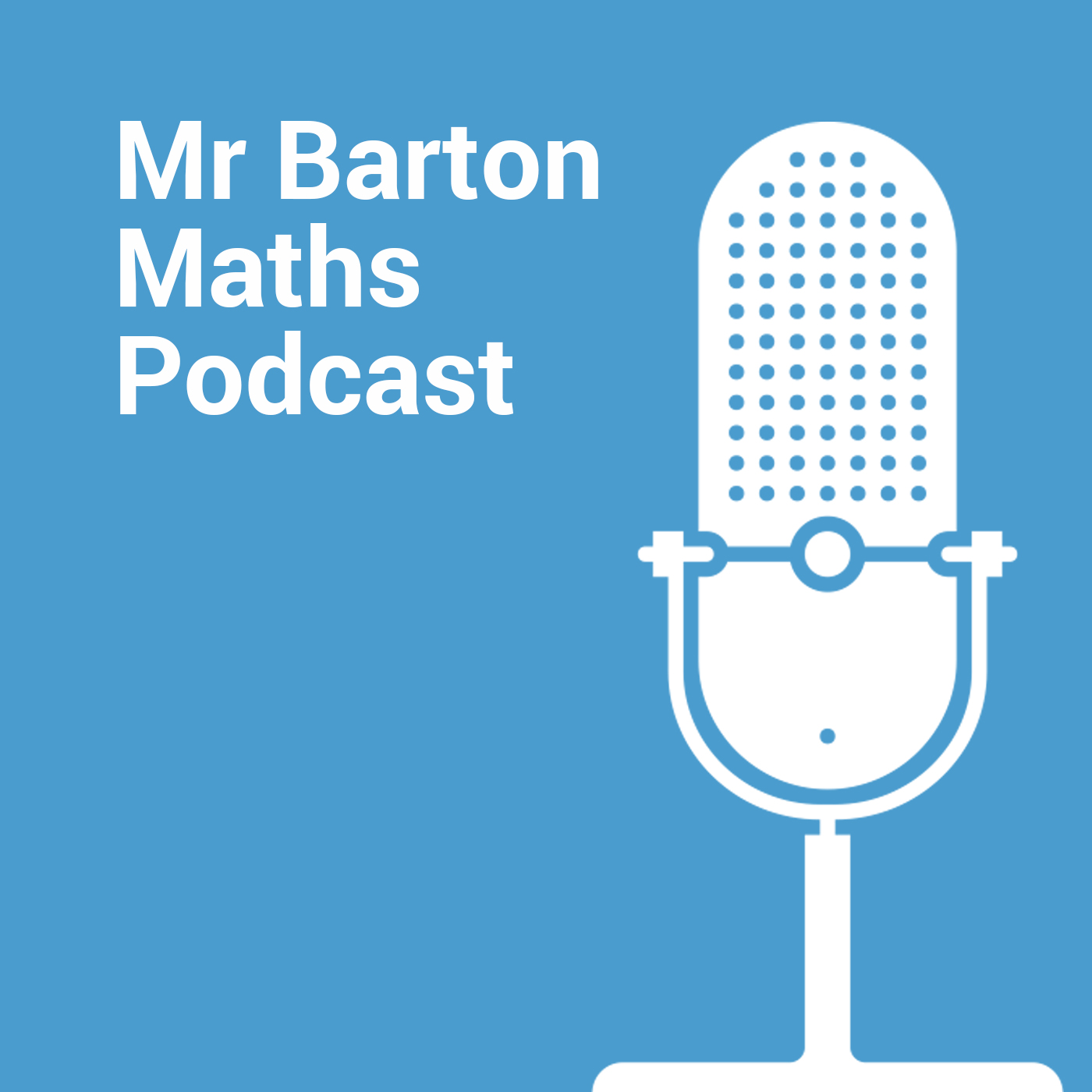
Craig Barton interviews guests from the wonderful world of education about their approaches to teaching, educational research and more. All show notes, resources and videos here: https://www.mrbartonmaths.com/blog/
Anne Watson and John Mason are two of the most influential people in the history of mathematics education. Their books, papers and workshops have influenced generations of maths teachers and this directly improved the experience of teaching and learning maths for hundreds of thousands of students. In this interview we look back over their careers, and then dive deep into the principles of Variation Theory, how to ask good questions and the importance of visualisation.
For more information about today’s guest, plus links to the websites, resources and ideas they mention, please visit the show notes page: http://www.mrbartonmaths.com/blog/anne-watson-and-john-mason-variation-questioning-visualising-and-developing-mathematical-thinkers/

On this episode of the Mr Barton Maths Podcast, I spoke to Anne Watson and John Mason
Now, I started the Mr Barton Maths Podcast over two years ago purely so I could talk to and learn from my heroes. And I have been ridiculously lucky with the guests who have been kind enough to give up their time to talk to me – Dylan Wiliam, the Bjorks, Doug Lemov, Kris Boulton, Bruno Reddy, the list goes on. But Anne and John have been at the top of my “Wanted List” for some time now. I finally plucked up the courage to ask when I saw John at an event in London, and I am so glad that I did. Their influence on mathematics education is unrivaled, and their knowledge and experience is phenomenal. Indeed, in the time since they agreed to talk to me to the interview itself, I have been revising like it was my finals at uni – the only difference being I was slightly more sober this time.
In their incredibly distinguished careers, John and Anne have found time to be the authors of one of my all time favourite books: Questions and Prompts for Mathematical Thinking, and the co-authors, along with Chris Bills and Liz Bills of another: Thinkers: activities to promote mathematical thinking. Both of these are linked to in the show notes, along with everything else we discuss in the interview.
And when I announced on Twitter that Anne and John were coming on the show, the reaction was incredible. In fact, it was summed up nicely by the following Tweet from Anushka Rao who said: Give them my love all the way from India ! In this land of gods, they’re still my main ones 🙂
So, in an incredibly wide-ranging conversation we discussed the following things, and much, much more besides:
- Anne and John’s discussions about their career to date lead to some fascinating tangents about the nature of instruction and the importance of promoting “mathematical thinking” for all children – something that is a recurring theme throughout the interview
- About an hour into the interview, we turn our attention to Variation Theory, as I ask What are the key principles of variation theory, and why is a careful consideration of variation and invariance important when putting together examples to introduce concepts and exercises for students to complete?
- I explain how I find it hard to get the balance right between too much and too little changing, and we discuss the concepts of going with or across the grain
- We talk about the importance of encouraging students to form expectations about answers, and the beauty of a mathematical surprise
- Why don’t Anne and John like the question “what do you notice?”, and what question do they prefer instead?
- As the co-authors of Thinkers, I had to ask what advice would Anne and John have for a teacher listening who wanted to improve their questioning ability?
- I have heard John say that lesson planning should be mental imagery, not writing lesson plans, and I ask him to expand on that
- Anne gives possibly my favourite ever answer to the question what do you wish you had known when you first started your careers that you know now?
- And then finally they reflect on recommended books, followed by a brief discussion about what they thought of my book – which got my heart racing again, just as I was starting to relax.
Sometimes when you meet your heroes it does not live up to expectations. Fortunately, the experience of talking to Anne and John for over two hours was better than I could have hoped. I loved the first half of the conversation, hearing about their careers, experiences and beliefs, and then I loved the second half, where I try to drill down into the practical takeaways so we can all learn from their experiences. As ever, I will reflect on some of the many things I have taken away from this interview in my Takeaway at the end of the show.
Speaking of my Takeway, having listened it, Anne and John disagree – can you believe it?!? – with my belief concerning what I consider to be the winning combination of direction instruction versus what I call Intelligent Practice. I have included their comments in the show notes, followed by a brief reply by me, so you can read them and see who you agree with after you have listened to the interview and the Takeaway. I think the safe money is with Anne and John 🙂
The usual plug for my book: “How I wish I’d taught maths”, which contains an entire chapter on my person take on the importance of the choice of examples and practice questions we give our students, which has been heavily influenced by the work of Anne and John and the principles of Variation Theory that we discuss throughout this interview.
Anne and John’s response to my takeaway:
Now about your post-interview comments – lots of interesting stuff here but one thing worries us which is about the ‘direct instruction’ you talk about. If students know what a unit fraction is then finding something like two-fifths depends only on being able to find one fifth and then knowing how to get two of something, and we would not agree that you HAVE to directly instruct them to find any fraction of any amount – you can instead be sure they understand how to find unit fractions of any amount and what to do with them. The point is surely that if you have one fifth of something (i.e. unit fractions as operators) then working out two-fifths is a problem to be solved rather than a method to be applied, and then if you next ask me about three fifths I can try and apply the same method I have just invented, and hey presto if I am aware of that I can construct for myself a way to do it in future based on meaning
My reply:
I also agree that – in this instance – you would not “have” to direct instruct students how to find, for example, 2/5 like you may have to to enable them to find 1/5. However, it is my preferred way of doing so in this case. Let me try to explain why. I want my students to have a method to find any fraction of any amount. This method would be something we had discussed, and then it would be introduced via the Silent Teacher and Example-Problem pair approach I describe in detail in my book. I firmly believe this is the best way to give all students the greatest chance of being able to use the method successfully. The purpose of (what I call) the Intelligent Practice that follows is not so they can discover how to find 2/5, but to look at how the answer – using the method I have taught them – to 2/5 is related to 1/5, and likewise how that answer is related to the answers to the connected questions that follow. It is in these relations where real understanding develops. So, my sequence of intelligent practice questions may look like this:
I guess it comes down to a choice of order. I prefer my students to do it this way around so they always have a method to fall back on – on which they can carry out successfully – and it is this method that allows students to notice the relationships between the questions and answers, and hence start to appreciate the deep underlying structure. I hope that makes some kind of sense!
On Twitter, John is @JohnMOxford
Anne and John’s website is: pmtheta.com
Their book Thinkers: activities to promote mathematical thinking is available from the ATM here
Another influential book of theirs Questions and Prompts for Mathematical Thinking is available from the ATM here
The Structured Variation Grids (SVG) that John describes can be found here
The paper Seeing an exercise as a single mathematical object can be downloaded as a pdf here
Maths teacher Danny Brown has written a lovely blog post about questioning based on this interview
To see the complete selection of books recommended by all my podcast guests, click here.
Anne Watson and John Mason’s Big 3 (or Big 5!)
1. Underground maths
2. What We Owe Children: The Subordination of Teaching to Learning by Caleb Gattegno
3. Polya’s video “Let us teach guessing”
4. How children fail by John Holt (available for free as a pdf here)
5. How To Teach Mathematics for Mastery by Helen Drury
My usual plugs:
- You can help support the podcast (and get an interactive transcript of all new episodes) via my Patreon page at patreon.com/mrbartonmaths
- If you are interested in sponsoring an episode of the show, then please visit this page
- You can sign up for my free Tips for Teachers newsletter and my free Eedi newsletter
- My online courses are here: craigbarton.podia.com
- My books are “Tips for Teachers“, “Reflect, Expect, Check, Explain” and “How I wish I’d taught maths”
Thanks so much for listening, and I really hope you enjoy the show!
Craig Barton

